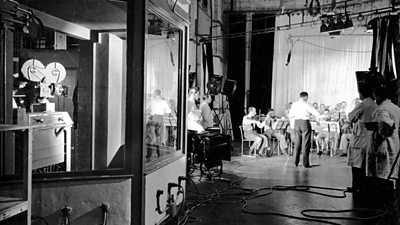The story of how the �鶹Լ�� abandoned Baird’s system for the technically superior cathode-ray tube stretches across four crucial years in the early history of television. And the �鶹Լ�� Oral History collection provides some intriguing eye-witness accounts of the process.
The Corporation had long been suspicious of Baird’s mechanically-scanned 30-line system, sensing that the picture quality was simply not good enough to persuade the British people to spend money on sets. Crucially, its engineers could see little room for improvement, either, given its use of medium wave, which set clear limits on the quality of what could be transmitted.
As Peter Eckersley, the �鶹Լ��’s chief engineer until 1929, put it: It was “an insult to the public to put on such a poor service and encourage the idea that the broadcast pictures would improve”. And, he went on, “if they were not improved they were not worth transmitting”.
Eckersley’s successor as Chief Engineer, Noel Ashridge was less dismissive of Baird’s approach. But once a clear alternative appeared –and the �鶹Լ�� had witnessed for itself EMI’s new electronic system, with its clearer and more stable pictures, in 1932 – the die was cast. It was really only the insistence of the Post Office – who had been lobbied hard by the Baird company, and who wanted to support a purely British business – that meant the �鶹Լ�� stuck with the Baird technology for as long as it did.
Nevertheless, in September 1933 the �鶹Լ�� informed Baird that it intended to “terminate the arrangement between us” the following year – and all �鶹Լ�� test broadcasts featuring the 30-line system were closed down by September 1935.

Although the original 30-line system was now obsolete, the Baird Company was soon achieving a much improved 240-line picture, aiming eventually to match EMI’s 405-lines. And, since the Government-appointed Selsdon Committee had required the �鶹Լ�� to continue using Baird along with the EMI system (which was now, in fact, the ‘Marconi-EMI’ system, after the two companies had combined forces), this meant that the �鶹Լ��’s experimental broadcasts to Radiolympia in August and September 1936, and its new regular ‘high-definition’ public service launched on 2 November 1936, both had to be conducted by alternating between two very different sets of technology.
At Alexandra Palace there was Studio A, equipped with the Marconi-EMI system and its ‘Emitron’ cameras, and Studio B, which used the Baird system. There would be ‘Baird’ days, and then ‘Marconi-EMI’ days, with staff having to pile out of one studio and into the other at swap-over time. There even needed to be two sets of engineers.
Eye-witness accounts from �鶹Լ�� staff having to work with this dual system make it very clear which system they preferred. Baird’s studio involved a mechanical scanner and a revolving light – which required a presenter to be in darkness and wear special, rather hideously-coloured make-up; the Marconi-EMI studio was fully-lit and worked perfectly well with ordinary make-up.
One other strange feature of the Baird system was that it involved an ‘intermediate film’ process: images had to be processed onto celluloid before being played-out. Producers and directors were irritated by this cumbersome element, not least because they regarded the essence of television to be its liveness. However, as Cecil Madden reveals in his �鶹Լ�� Oral History interview, there were some on-screen performers who managed to discover an upside:
After the November 1936 launch of the regular television service, the �鶹Լ�� was supposed to wait another six months before passing final judgement on which of the two systems should be adopted permanently. But once the Alexandra Palace staff were busy making and broadcasting programmes every day, it became obvious much sooner that things couldn’t go on as they were. In his interview, the �鶹Լ�� engineer Harold Bishop gives an account of the final decision:
In fact, one element of Baird’s system did survive: his ‘flying spot’ process was well-suited to scanning film, so for several decades it became the basis of so-called ‘telecine’ processes – that is, turning film into video. But as the central technology of television, the Baird system was dead. The final nail-in-the-coffin came when the �鶹Լ�� introduced ‘London television standards’ - 405-lines and 50 pictures per second - for all future broadcasts. This meant that Baird’s 240-line, 25 pictures per second system, previously categorized as ‘high-definition’, failed to pass the new threshold.
So what does the �鶹Լ��’s abandonment of Baird’s technology mean now for the reputation of John Logie Baird himself as an ‘inventor’ of television? Indeed, might it be fair to say that the �鶹Լ�� ‘robbed’ him of his true place in history? In his 1978 interview, Stuart Williams, who knew Baird personally, as well as professionally through his work in outside broadcasting, was asked to reflect on this question:

